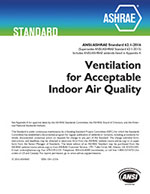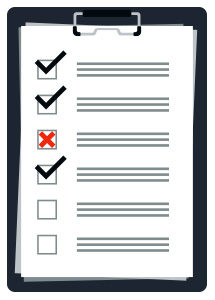 ASHRAE 62.1 Standard for Ventilation for Acceptable Indoor Air Quality provides recommendations for minimum ventilation rates and other parameters to ensure good indoor air quality (IAQ). Keeping the IAQ at a safe level will help to minimize any adverse health effects caused by air quality factors.
ASHRAE 62.1 Standard for Ventilation for Acceptable Indoor Air Quality provides recommendations for minimum ventilation rates and other parameters to ensure good indoor air quality (IAQ). Keeping the IAQ at a safe level will help to minimize any adverse health effects caused by air quality factors.
The 62.1 standard is intended for both new building and building addition projects. It can also be used as a guide for the improvement of IAQ in existing buildings.
In order to properly conform to the ASHRAE 62.1 standard, it is necessary for sensors to be both stable and accurate.
Stability
Stability is defined as a change (or lack of change) in accuracy over a period of time. Drift is commonly used as a specification to illustrate the stability.
 To conform to ASHRAE 62.1, it is important that sensors that control outdoor air delivery, monitor air flow, and measure CO2 do not drift over time. Drift can result in an inaccurate reading, which will provide incorrect air flow, pressure, and/or CO2 measurement to the air handler. This, in turn, can provide an inadequate amount of outside air to enter the building and result in suboptimal air exchange rates.
To conform to ASHRAE 62.1, it is important that sensors that control outdoor air delivery, monitor air flow, and measure CO2 do not drift over time. Drift can result in an inaccurate reading, which will provide incorrect air flow, pressure, and/or CO2 measurement to the air handler. This, in turn, can provide an inadequate amount of outside air to enter the building and result in suboptimal air exchange rates.
For this reason, you should consider:
- Incorporating backup monitoring devices as a control standard to catch drift early
- Using sensing devices that have great long-term stability
 Keeping a separate device as a control (or check) standard will allow you to develop a history of your products and keep track of any performance issues. Once you notice drift, you’ll be able to send your products in for recalibration to return them to factory specification. It is important to monitor this information and follow a consistent recalibration schedule for your sensors.
Keeping a separate device as a control (or check) standard will allow you to develop a history of your products and keep track of any performance issues. Once you notice drift, you’ll be able to send your products in for recalibration to return them to factory specification. It is important to monitor this information and follow a consistent recalibration schedule for your sensors.
In addition to monitoring your device performance, selecting sensors with long-term stability can reduce the frequency of necessary recalibration services (because your sensor stays accurate for a longer period of time with less drift). Every time a unit has to be sent in for recalibration, it results in downtime for your business, costing you potential revenue and calibration fees.
Note: Be sure to follow industry standard requirements for recalibration frequency for your application. For critical applications, calibration checks may be needed more frequently to ensure health and safety standards are being met and recorded. Guidance on determination of calibration intervals for your application can be found on NCSLI’s website.
Accuracy
While stability is important in any HVAC system, accuracy is critical as well. Accuracy is the maximum difference between the sensor’s measurement and the actual value.
There are different methods to specify accuracy. The International Electrotechnical Commission (IEC) outlines three types of non-linear properties:
- Hysteresis – the difference between the maximum deviation in the output between consecutive increasing and decreasing full span pressure cycles
- Non-repeatability – the maximum difference in output when the same pressure is applied, consecutively, under the same conditions and approaching from the same direction
- Non-linearity – Best Fit Straight Line (BFLS) and Terminal Point are the two most common methods of calculating non-linearity
There are two different accuracy baselines:
- Best Fit Straight Line
- Terminal End Point
Finally, there are two typical calculations used for determining accuracy. When comparing devices, it is important to note what type of accuracy calculation was used for each device.
- Root of the Mean Squared (RMS)
- Root of the Sum Squared (RSS)
If sensing devices are accurate to begin with and have great long-term stability, then the HVAC system that they are installed on will run more efficiently. Proper ventilation, air quality, and humidity measurements are outlined in ASHRAE 62.1.
Use stable and accurate devices to meet ASHRAE 62.1 standards

Utilizing pressure, relative humidity, CO2, and air velocity sensors that offer stability and accuracy in building HVAC systems will ensure the building is ventilating properly, has suitable indoor air quality, and is operating efficiently.
Dwyer has several products that are both stable and accurate, which can help meet ASHRAE 62.1 standards, including:
- Series MSX Magnesense® Differential Pressure Transmitters
- Series MSX Pro Magnesense® Differential Pressure Transmitters
- Series RHP Humidity/Temperature Transmitter
- Series CDT Carbon Dioxide/Temperature Transmitter
- Series AVUL Air Velocity Transmitter
 In addition to a stable product lineup, Dwyer offers a variety of calibration services for new or previously purchased products. Our Engineering Laboratory has been accredited by the ANSI National Accreditation Board and meets the requirements of ISO/IEC 17025:2017 for select calibration services.
In addition to a stable product lineup, Dwyer offers a variety of calibration services for new or previously purchased products. Our Engineering Laboratory has been accredited by the ANSI National Accreditation Board and meets the requirements of ISO/IEC 17025:2017 for select calibration services.
Please reach out if you have any questions about stability, Dwyer products, or our calibration services. The Dwyer team is always happy to assist with any of your needs and can be reached via phone or email.

